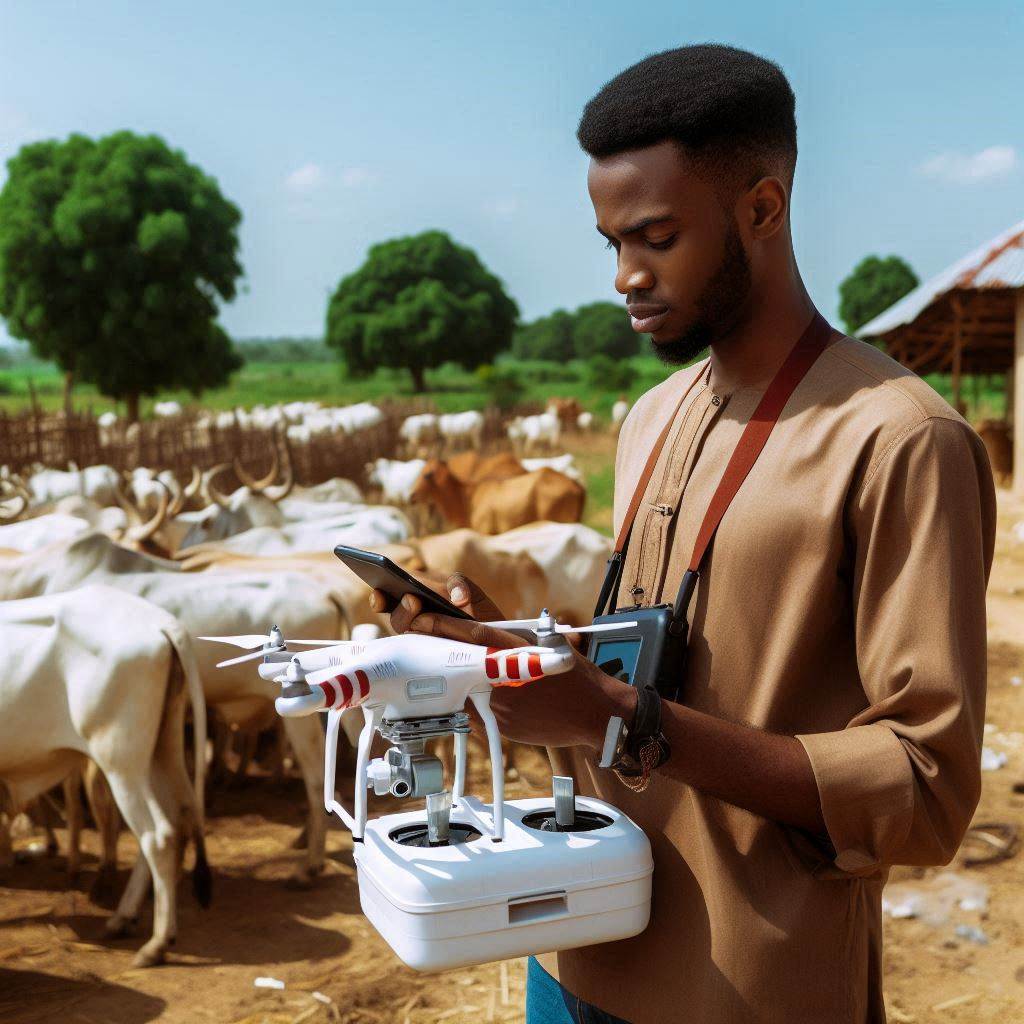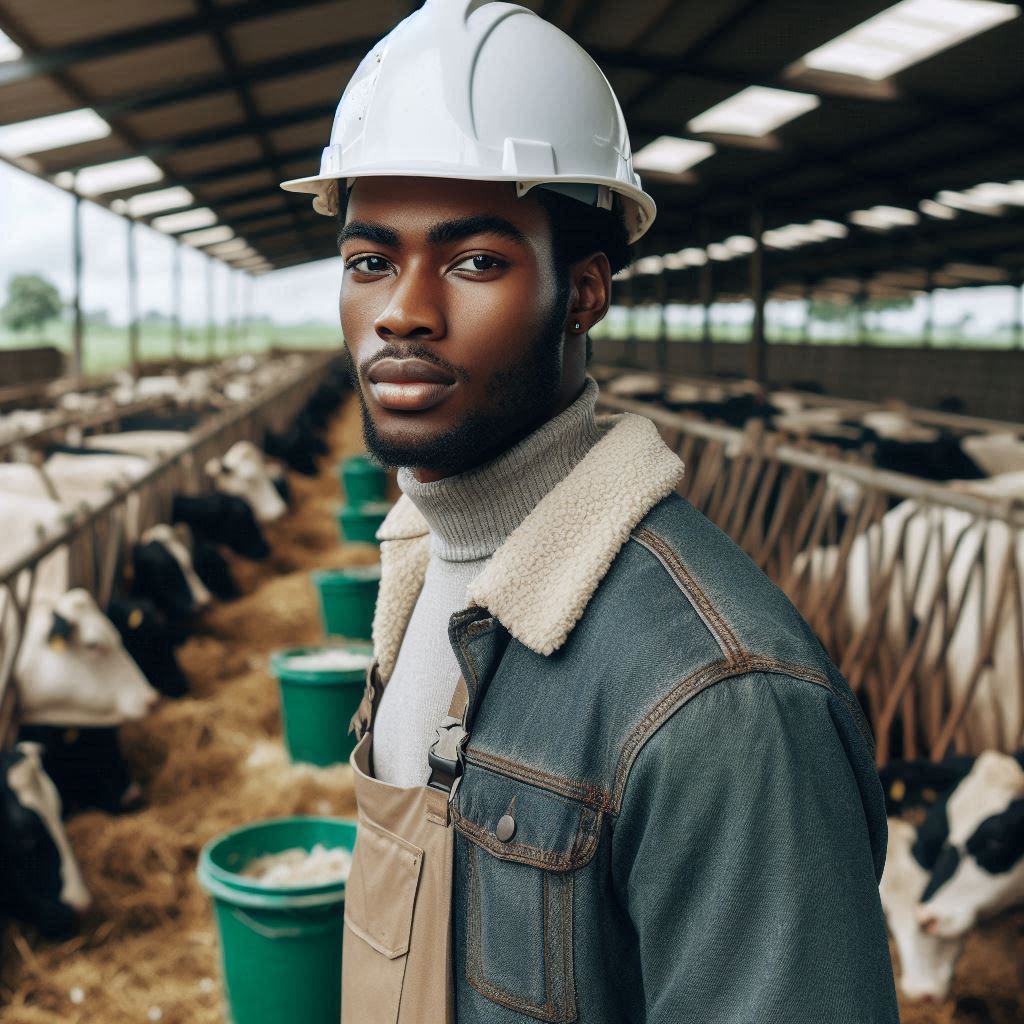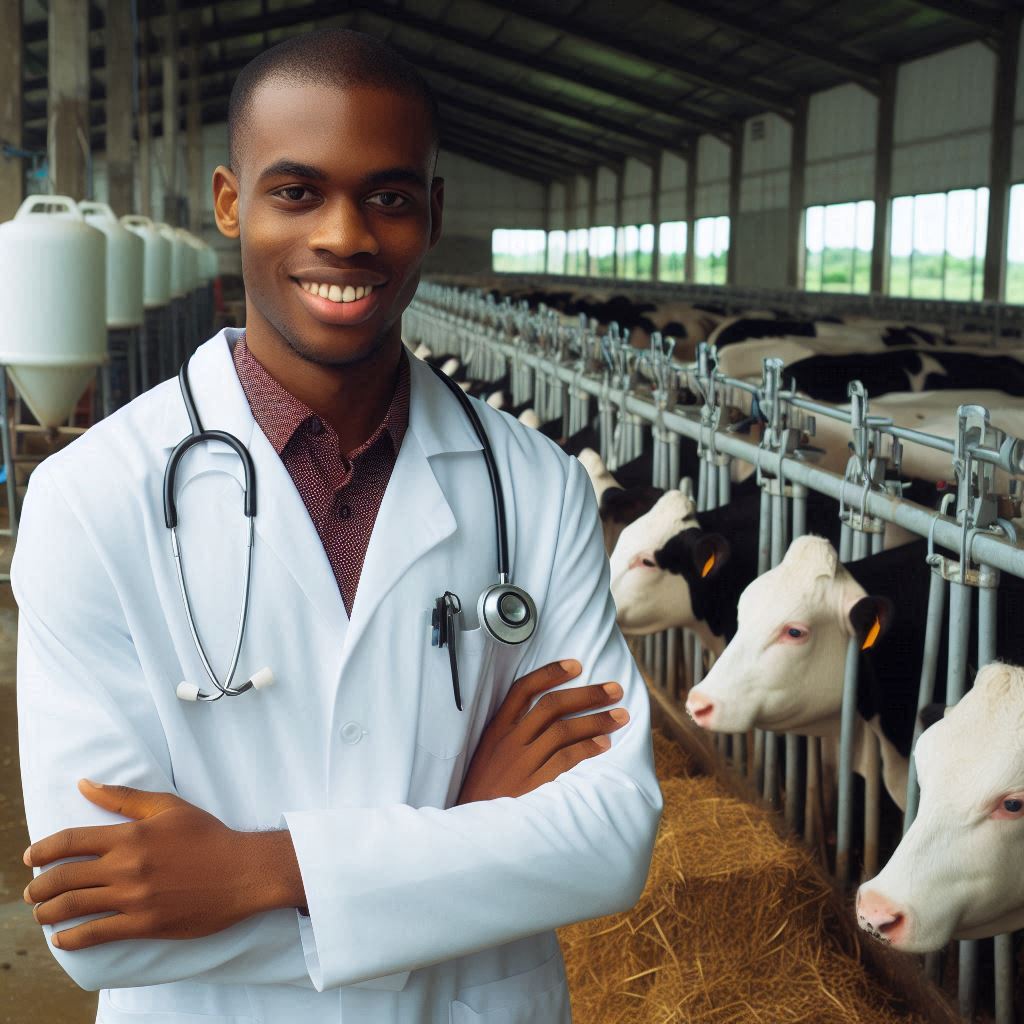Introduction
The integration of drones into livestock monitoring practices marks a significant advancement in agricultural technology.
These unmanned aerial vehicles promise a plethora of benefits, reshaping the landscape of livestock management.
By harnessing the power of aerial surveillance, drones provide farmers with unprecedented insights into their herds, allowing for proactive decision-making and enhanced efficiency.
Gone are the days of labor-intensive manual monitoring; drones offer a cost-effective and time-efficient alternative.
Equipped with advanced imaging technology, they can capture high-resolution images and videos, enabling farmers to assess the health and behavior of their livestock with precision.
Moreover, drones facilitate the monitoring of vast expanses of land that would otherwise be inaccessible or challenging to survey on foot.
In this section, we delve into the myriad advantages of employing drones in livestock monitoring.
From reducing the incidence of livestock theft and predation to optimizing grazing patterns and identifying potential health issues early on, drones play a pivotal role in modernizing the agricultural industry.
As we explore the benefits in detail, it becomes evident that drones are not just tools; they are indispensable assets for farmers striving to maximize productivity while minimizing environmental impact.
Benefits of Using Drones
Improved Efficiency in Monitoring Large Areas of Land
Drones have revolutionized the way farmers monitor their livestock and land. One of the most significant advantages is their ability to cover large areas of land quickly and efficiently.
In the past, farmers relied on manual labor or manned aircraft to survey their properties, which could be time-consuming and costly. With drones, however, farmers can now survey hundreds of acres in a fraction of the time it would take using traditional methods.
Cost-Effective Alternative to Traditional Monitoring Methods
Another key benefit of using drones in livestock monitoring is their cost-effectiveness. Traditional methods, such as hiring helicopters or ground-based surveys, can be prohibitively expensive for many farmers.
Drones offer a more affordable alternative, requiring only a one-time investment in the equipment and minimal ongoing costs. This makes them accessible to a wider range of farmers, regardless of their budget constraints.
Real-Time Data Collection for Better Decision-Making
Drones provide farmers with real-time data and imagery, allowing for immediate insights into the health and behavior of their livestock. This real-time monitoring enables farmers to make informed decisions quickly, such as adjusting grazing patterns or identifying potential health issues early on.
By acting on this data promptly, farmers can prevent problems from escalating and ensure the well-being of their animals.
Reduction in Labor Costs and Human Error
Automation is another significant advantage of using drones in livestock monitoring. By automating monitoring tasks that would otherwise require manual labor, drones help farmers save time and reduce labor costs.
Additionally, drones eliminate the risk of human error associated with traditional monitoring methods, such as miscounts or inaccurate data collection. This increases the accuracy of the data collected, leading to more reliable decision-making.
Ability to Detect Potential Issues Early and Prevent Loss
Perhaps the most critical benefit of using drones in livestock monitoring is their ability to detect potential issues early and prevent loss. Equipped with advanced sensors and cameras, drones can identify signs of disease, distress, or environmental hazards before they become serious problems.
This early detection allows farmers to take proactive measures to mitigate risks and prevent loss, ultimately saving time, money, and resources in the long run.
Generally, the benefits of using drones in livestock monitoring are vast and varied. From improved efficiency and cost-effectiveness to enhanced decision-making and risk mitigation, drones offer a transformative solution for modern farmers.
By harnessing the power of drone technology, farmers can optimize their operations, increase productivity, and ensure the welfare of their livestock for years to come.
Read: Comparing Forestry Curriculum: Nigeria vs. Global Standards
Environmental Impact
Reduced Greenhouse Gas Emissions Compared to Traditional Methods
Drones offer a game-changing approach to livestock monitoring that extends beyond productivity gains. Their environmental benefits are profound, contributing to sustainable farming practices and minimizing the ecological footprint of agricultural operations.
One of the primary environmental advantages of using drones in livestock monitoring is the reduction in greenhouse gas emissions.
Traditional methods often involve the extensive use of vehicles, which emit carbon dioxide and other pollutants into the atmosphere. In contrast, drones operate on electricity, making them significantly more environmentally friendly.
Minimal Disturbance to Livestock and the Environment
Furthermore, drones minimize disturbance to both livestock and the surrounding environment. Unlike ground vehicles or helicopters, which can startle animals and disrupt their natural behavior, drones operate at a safe distance, causing minimal interference.
This non-invasive approach not only reduces stress among the livestock but also preserves the integrity of the ecosystem.
Moreover, drones facilitate precision agriculture practices, further enhancing their environmental impact. By capturing high-resolution aerial imagery and data, farmers can make informed decisions regarding resource allocation, crop management, and grazing patterns.
This targeted approach optimizes resource use, reduces waste, and minimizes the need for chemical inputs, thus promoting sustainable farming practices.
Precision Agriculture Practices for Sustainable Farming
Incorporating drones into livestock monitoring enables farmers to monitor vegetation health, soil moisture levels, and crop growth with unparalleled accuracy.
This real-time data allows for timely interventions, such as adjusting irrigation schedules or applying fertilizers only where needed, thereby minimizing environmental degradation and promoting ecosystem resilience.
Additionally, drones aid in the identification and mitigation of environmental risks, such as soil erosion, water pollution, and habitat loss.
By monitoring sensitive areas and detecting potential threats early on, farmers can implement proactive measures to protect the environment and mitigate negative impacts on biodiversity.
Basically, the environmental benefits of using drones in livestock monitoring are substantial. From reducing greenhouse gas emissions and minimizing disturbance to facilitating precision agriculture practices, drones offer a sustainable solution to modern farming challenges.
By harnessing the power of technology to promote environmental stewardship, farmers can achieve both productivity and ecological harmony on their lands.
Read: Career Prospects in Forestry: Opportunities in Nigeria & Beyond
Case Studies
Examples of Successful Drone Usage in Livestock Monitoring
In the realm of livestock monitoring, drones have emerged as invaluable tools, revolutionizing traditional practices. Several case studies illustrate their effectiveness in enhancing productivity and profitability for farmers.
One such example comes from a cattle ranch in Texas, where drones were employed to monitor the health and behavior of the herd.
By conducting regular aerial surveys, the rancher was able to detect signs of illness or distress early on, allowing for prompt veterinary intervention.
This proactive approach resulted in reduced mortality rates and improved overall herd health.
Similarly, in Australia, a sheep farmer utilized drones to track the movement and grazing patterns of her flock across vast expanses of land.
The aerial imagery provided valuable insights into pasture quality and availability, enabling the farmer to optimize grazing rotations and minimize overgrazing.
As a result, she reported significant improvements in both pasture health and lamb growth rates.
Positive Outcomes and Improvements in Productivity and Profitability
These case studies highlight the positive outcomes and improvements in productivity and profitability that can be achieved through the strategic use of drones in livestock monitoring.
By leveraging real-time data and aerial imagery, farmers can make informed decisions that optimize resource use, minimize waste, and maximize yields.
In addition to enhancing productivity, drones also offer cost-saving benefits for farmers.
By reducing the need for manual labor and expensive equipment, drones provide a more efficient and economical approach to livestock management.
This translates into higher profit margins and improved financial sustainability for agricultural operations.
Testimonials from Farmers and Experts in the Industry
The success stories of farmers who have integrated drones into their livestock monitoring practices are echoed by experts in the agricultural industry.
Dr. Sarah Johnson, a renowned livestock veterinarian, emphasizes the transformative impact of drone technology on animal health and welfare.
According to Dr. Johnson, drones not only enable early detection of health issues but also facilitate targeted interventions that minimize the use of antibiotics and other medications.
This, in turn, contributes to the overall sustainability of livestock farming and reduces the environmental impact of agricultural operations.
Therefore, the case studies, positive outcomes, and testimonials presented here underscore the significant benefits of using drones in livestock monitoring.
From improving animal health and pasture management to enhancing productivity and profitability, drones offer a multifaceted solution to the challenges faced by modern farmers. As technology continues to evolve, the potential for drones to revolutionize the agricultural industry remains limitless.
Read: Sustainable Forestry Practices: How Nigeria’s Universities Teach It

Regulations and Challenges
Overview of Current Regulations for Drone Usage in Agriculture
As drones become increasingly integrated into agricultural practices, understanding and adhering to relevant regulations is crucial. Currently, regulations governing drone usage in agriculture vary by country and region.
In the United States, for example, the Federal Aviation Administration (FAA) regulates the operation of drones for commercial purposes, including agriculture. Farmers must obtain a Remote Pilot Certificate and adhere to airspace restrictions and operational limitations set forth by the FAA.
Similarly, in Europe, the European Union Aviation Safety Agency (EASA) sets regulations for drone operations, with individual member states implementing additional requirements as needed.
Challenges Such as Privacy Concerns, Data Security, and Training Requirements
Despite the potential benefits, the adoption of drones in livestock monitoring is not without its challenges. Privacy concerns arise as drones capture aerial imagery that may inadvertently capture neighboring properties or individuals.
Data security is another significant challenge, as the information collected by drones, such as animal health data or farm layout, must be stored and transmitted securely to prevent unauthorized access or exploitation.
Additionally, training requirements pose a hurdle for farmers looking to incorporate drones into their management practices. Operating a drone safely and effectively requires training and certification, adding an additional layer of complexity to adoption.
Ways to Overcome Challenges and Incorporate Drones Effectively into Livestock Management Practices
To address privacy concerns, farmers can establish clear guidelines for drone usage and communicate with neighboring landowners to mitigate any potential conflicts. Implementing privacy safeguards, such as blurring or cropping sensitive areas in aerial imagery, can also help protect privacy rights.
Regarding data security, farmers should invest in secure storage and transmission protocols for drone-collected data.
This may involve using encrypted storage devices, secure cloud services, or implementing access controls to ensure that only authorized individuals can access sensitive information.
As for training requirements, farmers can take advantage of online courses, workshops, and certification programs offered by industry organizations and drone manufacturers.
By investing in comprehensive training for drone operators, farmers can ensure safe and proficient use of drones in livestock management.
In general, while regulations and challenges may pose obstacles to the widespread adoption of drones in livestock monitoring, proactive measures can help mitigate risks and maximize the benefits of drone technology.
By staying informed about regulations, addressing privacy concerns, enhancing data security, and investing in training, farmers can effectively incorporate drones into their management practices, ultimately improving productivity and sustainability in the agricultural sector.
Read: Forestry and Climate Change: Nigeria’s Response and Education
Conclusion
In summary, the adoption of drones in livestock monitoring represents a transformative shift in agricultural practices.
These unmanned aerial vehicles offer a myriad of benefits that resonate throughout the farming industry.
With drones, farmers gain access to real-time data and insights that enable informed decision-making and proactive management of their livestock.
This results in improved efficiency, as issues can be identified and addressed promptly, leading to better overall productivity.
Furthermore, drones provide a cost-effective solution for monitoring vast areas of land, reducing the need for labor-intensive manual inspections.
This not only saves time and resources but also allows farmers to allocate their efforts more strategically.
Moreover, by minimizing the reliance on traditional methods that may disrupt livestock and the environment, drones contribute to sustainable farming practices.
Their precision and accuracy promote optimal resource utilization, ultimately leading to improved profitability for farmers.
In closing, the integration of drones into livestock monitoring represents a win-win situation for farmers and the agricultural sector as a whole.
As technology continues to advance, the potential for drones to revolutionize farming practices and drive sustainable growth remains promising.




